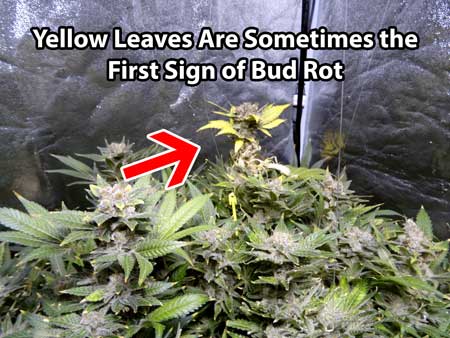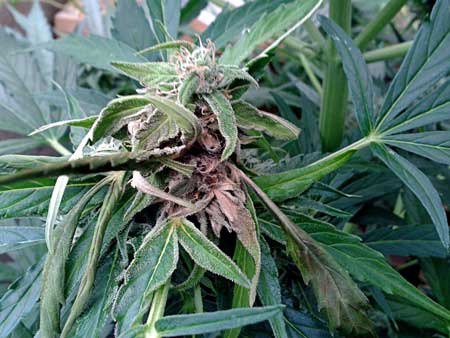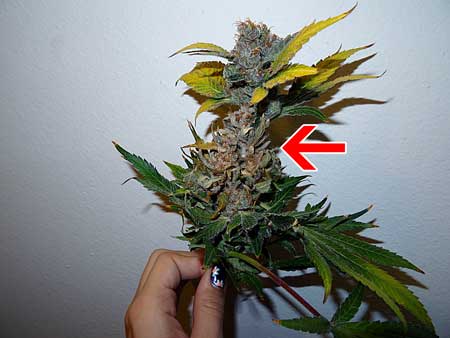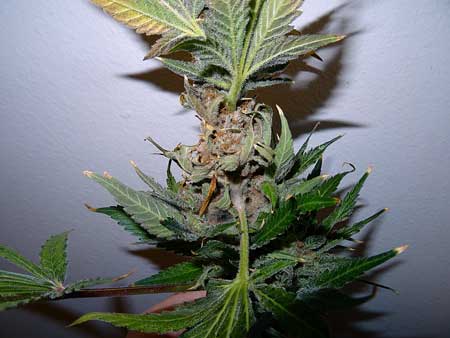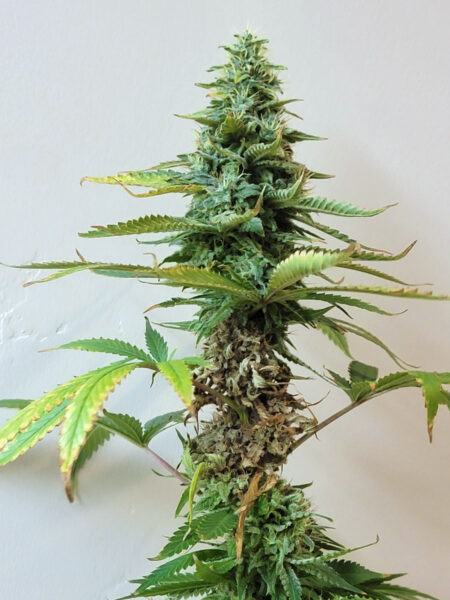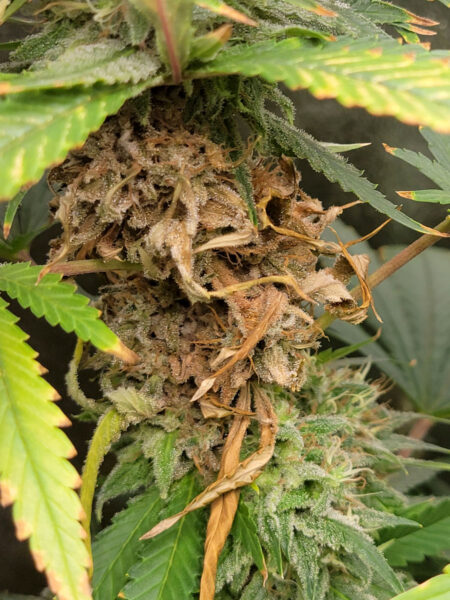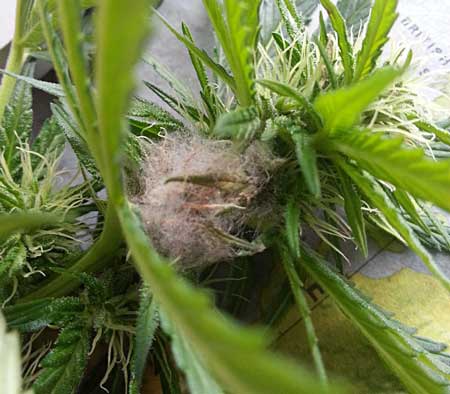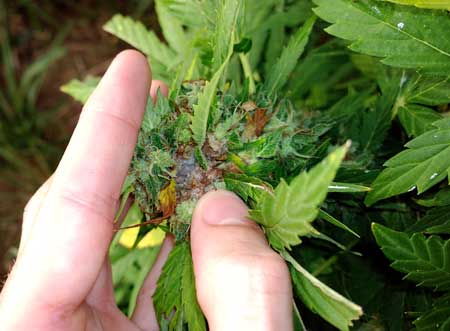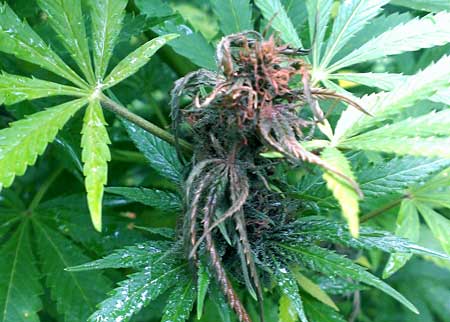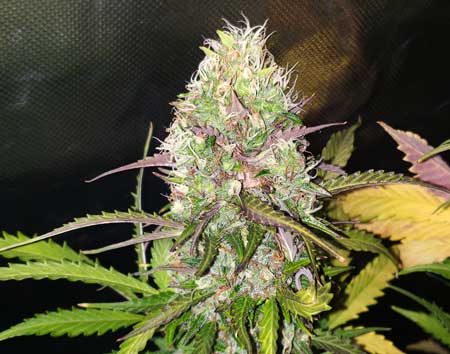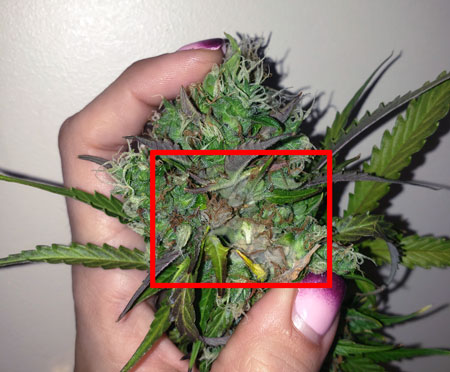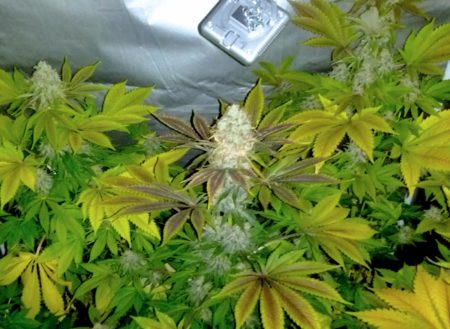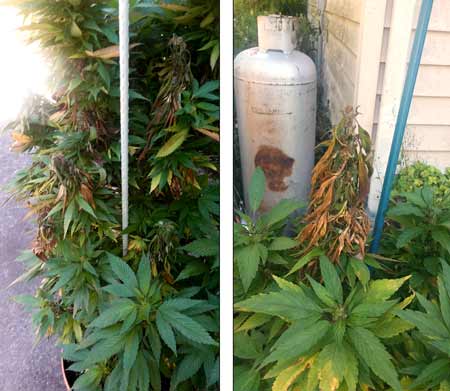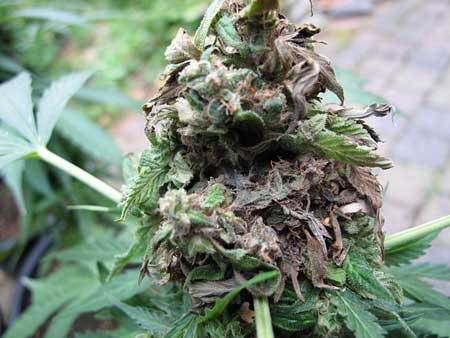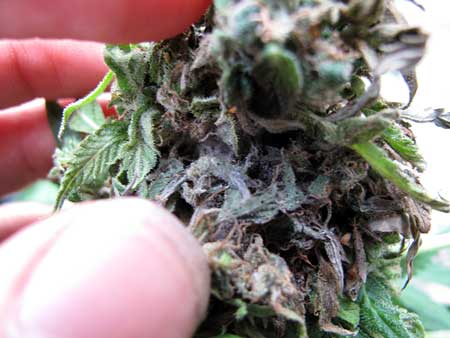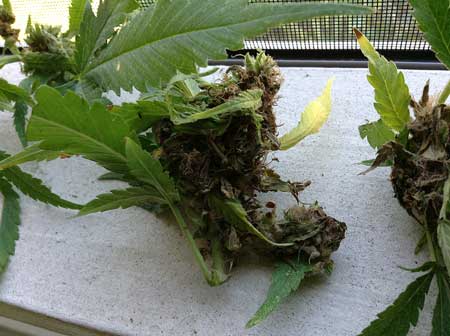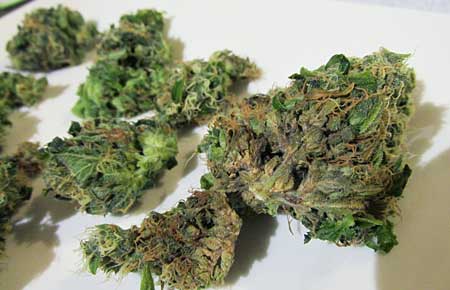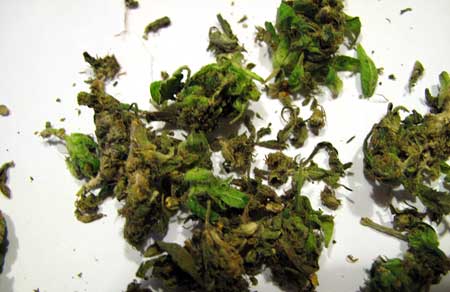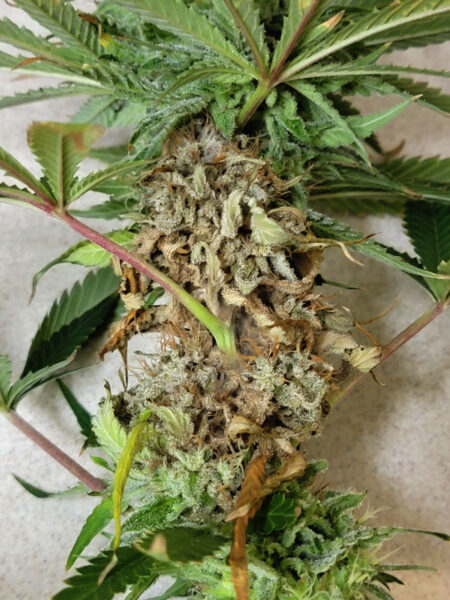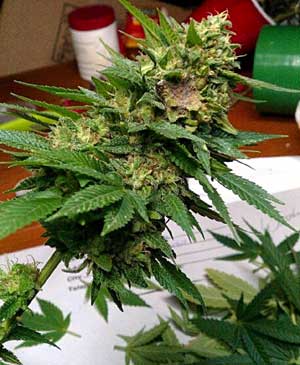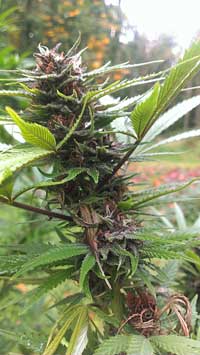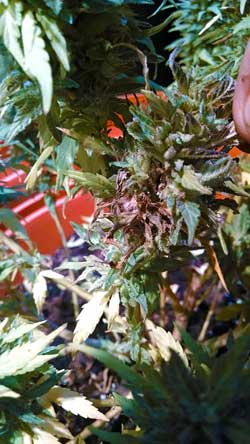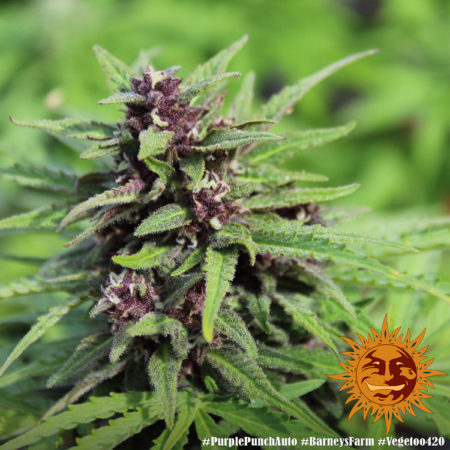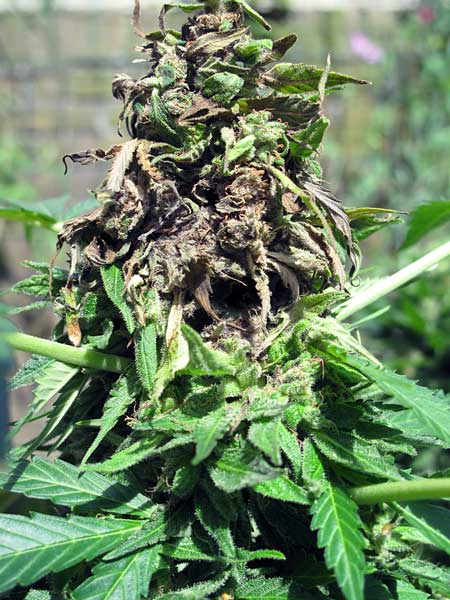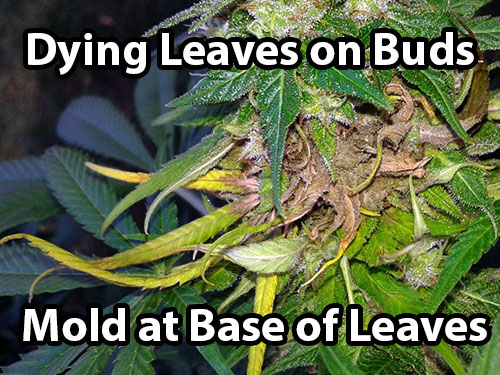
Bud Rot Caption: Example of cannabis bud rot.
by Nebula Haze
Cannabis bud rot (aka “Big Bud Disease” or “The Curse of the Successful Grower”) attacks your fattest, biggest buds right as they start to approach harvest time.
Too cruel… Bud rot attacks and kills your biggest, thickest buds. Often the first sign of cannabis bud rot is the leaves on a big bud suddenly die or turn yellow often over the course of 1-2 days. The base of these discolored leaves is where the bud is rotting. If you investigate closer, you will often be able to see the mold.
by Nebula Haze
How to Prevent & Stop Bud Rot (quick summary)
Avoid wet buds & high humidity – Bud rot is a fungus, and like all fungi, its spores needs a wet, humid place to germinate and grow. About 40-50% RH is ideal for the cannabis flowering stage (both for dense buds and to prevent bud rot). A humidity above 60% RH puts you at major risk of bud rot and mold, especially if you have lot of thick buds. Don’t allow buds to sit in damp or overly humid conditions for long. Indoor growers can use a strong dehumidifier to reduce humidity in the grow space if necessary. Outdoor growers can cover plants when it rains and shake them off when they’re wet. Another strategy for outdoor growers is to get short-flowering (ex: Pineapple Express #2) or auto-flowering (ex: Purple Punch Auto) strains so their plants are ready to harvest before the start of the local rainy season.
Great air circulation – Air should be moving over the buds and leaves as well as through the plant. Fans are a huge help indoors, especially if you set up an exhaust fan to vent hot humid air away from your plants. Oscillating fans can help prevent humid spots but only blow air around so they can’t lower the overall humidity. Outdoor growers can move potted plants to a breezier location but if plants are in the ground, unfortunately, there’s not much you can do to increase air circulation.
Defoliate extremely bushy plants – Each leaf is constantly adding water vapor to the air. That means removing leaves can help lower the humidity through and around the plant, especially in a small growing space. If you decide to defoliate because plants are covered in tons of leaves and the humidity is high, remove leaves that aren’t getting much light (typically the middle and bottom of the plant) since they aren’t making food for the plant anyway.
Watch long, dense buds for signs of discoloration – Almost like a cruel joke, bud rot usually attacks your biggest and most impressive colas 🙁 That’s why cannabis bud rot is sometimes known as “The Curse of the Successful Grower”.
Remove all buds affected by bud rot immediately – Carefully remove and discard all buds with bud rot, as well as nearby buds. This is a fungus that can spread quickly. Don’t let any of the dusty rot touch other parts of your plant to avoid spreading mold spores.
Consider harvesting early – If you can’t fix the environmental conditions that caused the bud rot (for example if it’s wet or humid and you can’t do anything about it), sometimes the best option is to harvest plants a little early to avoid further losses.
“When I had to throw away most of my plant due to bud rot, I cried a little, on the inside.”
~ Cannabis Grower
Table of Contents
What Does Cannabis Bud Rot Look Like?
Usually, a bud rot infection becomes visible on just certain parts of your cannabis plants. Indoors, it’s often the bigger and denser buds that get affected first. Outdoors you may get patches all over the plant, even on smaller buds, especially after a few rainy days.
With bud rot, certain areas on the colas (buds, hairs and/or attached leaves) start dying, in stark contrast to the rest of the buds. The changes happen quickly, within just a day or two. Affected buds may appear strangely colorful, yellow, or brown. Buds often appear dried up.
The deadened spots usually stand out and catch people’s attention, even if growers don’t know what’s wrong, they often instinctively know that something is wrong since the spots don’t look like the rest of the buds on the plant.
In addition to the rot itself, you may see white or gray fuzzy mold on the outside of the bud. With advanced bud rot, the bud will easily separate so you can see inside. When a bud with bud rot is inspected, it will be dark gray or brown on the inside, and possibly dusty (this “dust” is fungus spores).
Depending on the life stage or particular species of mold/fungi, bud rot can look…
white and fluffy
dark gray or brown (sometimes even dark purple)
the buds can be full of dark speckled dust which easily blows away (fungus spores)
“I lost half my plants last year to bud rot… After a couple of drizzly days, I noticed spots, and then I saw that it had spread to all my plants.”
~ Cannabis Grower
Sometimes you might see a few yellow leaves appear suddenly on some of your biggest colas. It can feel like it happens overnight. That could be a sign that there’s mold at the base of these leaves. Always investigate any cola with yellowing leaves ASAP. If there’s mold you will be able to see the leaves are basically falling out, with mold or brown spots being revealed in the middle 🙁
Usually, the bud easily splits at the base of the sick leaves to reveal the rot inside. At this point, there was still white mold inside, but within a day it would have darkened and the inside would look brown or gray.
Another example of marijuana bud rot from afar… (it’s that brown dead patch on the bottom half)
And here’s that same bud rot up close.
Different Stages of Bud Rot – Catch it Early!
When plants are afflicted by cannabis bud rot, it may start as fluffy white growth in the middle or sides of buds. This white mold quickly darkens into gray or brown and burrows deep into dense buds as the fungus takes hold. Sometimes you’ll see the initial stage on the sides of the buds, giving you a possible chance to catch the infection at an earlier stage.
The Botrytis fungus looks white and fluffy in its initial stage, but you’ll probably never even see this stage before the mold quickly darkens and starts rotting the buds from the inside out
Once bud rot has taken hold over parts of a cannabis plant, the buds can sometimes look almost the same on the outside, at first, but they usually start looking like they’re dying in patches. Often the area will dry out and easily pull apart. The inside of buds can turn brown, gray, or even purple.
“I noticed one brown sugar leaf and it came out unfortunately easily, exposing what was inside.”
~ Cannabis Grower
Some growers might think these drying spots mean that the plant is almost ready for harvest, but you know something is definitely wrong when just parts of the colas are being affected. Although many leaves turn yellow, sometimes they turn purple.
Here’s another example of a bud where the leaves turned purple in response to bud rot.
Upon closer investigation, the cannabis bud was rotting everywhere the leaves had turned purple.
Another example of marijuana leaves turning purple on a bud that’s rotting with bud rot.
Here’s an example of advanced bud rot on an outdoor cannabis plant. You can see leaves on the buds are dying in big patches. These buds are completely rotten on the inside.
Cannabis bud rot is caused by a type of fungus known as Botrytis cinerea. Sometimes you may get another type of fungus or mold that attacks the buds, but the cause, symptoms, and effects are usually similar.
In cannabis plants, Botrytis causes buds to rot out from the inside, hence the name “bud rot.” If you crack open an infected bud, the inside will be a moldy dark gray or brown.
Bud rot can cause different symptoms on different plants. For example, this cola (big main bud) responded to bud rot by turning purple and mushy. The leaves became crispy and started dying alongside the buds. This is what the grower came back to find after a few days of rain.
Did you know? In addition to cannabis bud rot, Botrytis causes problems for many different types of plants, including wine grapes, strawberries, and peonies.
The Botrytis fungus is sometimes referred to as “botrytis bunch rot,” “botrytis blight,” “bud rot,” “grey mould” or “gray mold.” When it comes to cannabis, it is often only called “Bud Rot” since that’s the main symptom cannabis growers are worried about.
Any part of the cannabis plant affected by bud rot should be discarded immediately! This helps prevent further infection and all buds touched by this toxic fungus should never be smoked or used.
Throw Away All Buds with Any Sign of Bud Rot! (brown is not a healthy bud color)
This is bud rot after the buds are broken apart. Not safe to consume.
There are different stages of Botrytis as it matures and tries to release spores. An infection starts as fluffy white mold (or brown mold) and then spreads throughout the inside of vulnerable buds. The inside of those parts of the colas darken to gray or brown. Once that has settled in, the mold tries to reproduce. The insides become filled with dark speckled dust that easily floats and spreads if the bud is cracked open. These are the spores of the fungus, so be careful to avoid breathing in letting this speckled dust ever touch other parts of your plants.
Luckily, healthy cannabis plants will usually not develop bud rot unless exposed to stagnant air and wet conditions or high humidity for an extended period of time. Your plants are also more susceptible to bud rot, fungus, or mold when the temperature is hot or cold. Aim for a temperature of 75°F (24°C) in the late flowering stage if possible (this also helps produce the highest quality buds).
How does the Botrytis fungus get to my plants?
Bud rot is spread to plants by dusty gray spores, usually in wind or water. If your plants are never exposed to these spores, they will never get bud rot.
Unfortunately, the spores can easily be carried to your plant by a breeze, rain, from contact with animals, or even by clones from another grow room. Indoors they may be floating around the air. Dormant spores can survive in many conditions only to affect your crops another time. It’s much more effective to try to prevent the conditions that allow bud rot to grow than to try to protect your buds from any contact with spores. That being said, infected buds can spread millions of spores and must be immediately and carefully moved away from your plants.
If you see rot like this, toss carefully so the rot can’t spread millions of spores over your other buds.
The fungus will never germinate if you keep buds in great environmental conditions. The spores are also more likely to take residence in your buds if there is some sort of “wound” on the plant. Possible wounds that can let Bud Rot fungus in include cracks in the stem from wind or over-training, damage from caterpillars, snails, worms, white powdery mildew, other pests, and larva. Any injury or weak point can be a good point of entry for bud rot spores into the plant.
Bud Rot needs wet or humid conditions to thrive. Even if your plant gets exposed to spores, you can usually prevent a bud rot infection by providing your cannabis with a moderate, dry, breezy environment (much easier indoors than outdoors).
What triggers spores to grow into a full-blown case of bud rot?
Wetness or High Humidity <– MOST IMPORTANT FACTOR, DON’T IGNORE THIS!
This is the most important factor. If you’re suffering from bud rot or mold, even if you remove the affected buds, it will likely keep spreading until you fix the humidity and keep buds dry.
- High humidity (above 55-60% RH) is the biggest contributor to mold growth and bud rot
- Leaves should not be touching each other creating wet spots (defoliate plants that are too bushy)
- Any situation where buds remain wet or in humid air for several continuous hours can be a trigger for bud rot
- Great air circulation in the grow space helps prevent any mold or fungus from growing
Outdoor
- Bud rot is often triggered by rainy or humid weather, especially if it lasts for days in a row
- If outdoor plants collect dew during the night or get rained on, consider shaking plants to remove as much moisture as possible
- Frost can also trigger bud rot because it creates wet spots when it melts
Cool Air Below 60°F (15°C) Can Trigger Bud Rot
- The Botrytis fungus thrives in the 50-60°F (10-15°C) temperature range. So if you have a bunch of cool, rainy days, it creates the absolute perfect home for Botrytus to grow.
Freezing Temperatures Can Trigger Bud Rot Outdoors
When temperatures fall, you may see frost on your leaves. The freezing temperatures are hard on your plants already, and then when the frost melts it creates an ideal environment for spore germination of the Botrytis fungus on outdoor plants. It’s common to get bud rot outdoors if it’s hitting freezing temperatures (or close to it), and causes freeze/melt cycles. Protect plants from frost in the flowering stage if at all possible. If you do get frost and it melts, make sure to shake the plants to get rid of excess moisture on the leaves or buds (just like you would after dew or rain). If the weather is not going to improve, it may be a good idea to harvest now.
Heat Triggers Mold and Fungi When Combined with High Humidity
Many different types of mold can strike thick buds with symptoms similar to Botrytis, and warm temperatures are ideal for most other relevant species of mold that cause bud rot. Every degree above 75°F or 24°C tends to increase the chance of many kinds of mold especially in high humidity (mold typically won’t grow below those temperatures indoors). Since botrytis can strike at lower temperatures, it’s recommended to aim for a medium of about for 70-75°F or 20-24°C if possible if it’s humid and you’re worried about bud rot or mold in the late flowering stage.
Bad Air circulation
Stagnant air invites bud mold. The lack of wind or air circulation over the top, underneath, and/or through the inside of the plant, helps provide fungus and mold a good place to grow
Leafy plants tend to collect water in between leaves and create humid pockets of air. This can cause wet spots and prevent air circulation through the plant, which also makes a good environment for mold or fungus.
“My fan could not circulate the air behind those colas. I thought it would be okay, but then I noticed super white fuzzy areas. Next thing I knew, half the colas had dead spots.”
~ Cannabis Grower
Big Fat Buds
Massive colas have moist conditions on the inside which don’t get exposed to air. This makes them a prime target for Botrytis bud rot or other types of mold.
It’s a cruel irony that you usually only get attacked by bud rot after producing lots of big buds. Bud rot has earned the moniker “Curse of the Successful Grower”.
Sick Plants
- Many types of stress, including bud rot, are more likely to hit your plant if it’s sick or suffering from nutrient deficiencies.
Certain strains are more susceptible than others to bud rot
Some strains are very mold-resistant, while others have little defense.
- Here’s a list of a few mold-resistant strains
How to Control Bud Rot (these are most important!)
Focus on keeping the humidity under 50-55% (most important!) and give plants plenty of air movement in a moderate environment.
These are the most important points to remember…
Keep humidity under 50-55% RH (Most important!) – This is the most important thing you can do to prevent bud rot from growing. It’s extremely rare to see Botrytis in dry conditions. Learn how to control the humidity. If you don’t fix high humidity, the bud rot will likely keep spreading even after you’ve removed all the affected buds.
Good air movement – Create good air circulation and make sure there’s always plenty of air moving over all the buds and leaves. Make sure your plants are getting access to cool, fresh air.
Protect plants from heat/cold or big temperature swings – Controlling temperature and keeping the grow space from experiencing big temperature changes can go a long way. Aim for 75°F or 24°C when you’re worried about bud rot, and avoid letting plants get overly hot or cool.
Avoid letting buds get exposed to wetness – Don’t allow buds to sit in damp or overly humid conditions for long. Protect your plants from rain and shake them if you notice they’re wet from rain or covered with dew.
Remove all affected buds immediately – Carefully remove and discard any and all buds that have possibly been affected by bud rot. Don’t let any rot touch other parts of your plant. This helps prevent bud rot from spreading, but it’s not enough if you don’t take care of the environment. Remember, the spores are always around, and it’s just a matter of whether they get the right conditions to grow.
Other tips to help prevent bud rot…
Avoid plant wounds. Avoid injuring your plants, especially in the flowering stage. Don’t leave open wounds to seep out water and nutrients. Instead, cover any open injuries with tape or some other “cast” until the injury closes up. Avoid pests like caterpillars or broad mites which burrow inside the plant, and overall try to keep plants healthy. A healthy plant is much less susceptible to all kinds of infections.
Keep some space between big buds. Cramming a bunch of plants with a lot of buds in a small space can increase the chance of bud rot. Buds should never be touching each other. Try to make sure every big bud has a little “breathing room” to itself.
Defoliate leafy plants. Remove some leaves on excessively leafy plants to help lower the humidity and overall moisture levels within the plant and around the buds. This is most effective indoors in a small space where the plant is greatly raising the humidity, but it can also be helpful outdoors. Remove any leaves are touching each other creating wet spots between them, or any big leaves that are covering or touching bud sites. Your plant won’t “mind” if you only remove leaves from leafy areas.
Watch out for symptoms of bud rot. Watch plants closely for signs of bud rot in the late flowering stage, especially on large or dense buds, and especially after humid or wet weather. If you notice leaves dying in patches on your plants, don’t wait. Investigate immediately.
When growing outdoors…
Get a strain meant for your local climate. If you live in a place with short summers and gets humid or rainy early in the fall, don’t get a strain that was developed near the equator.
There are fast-flowering, mold-resistant cannabis strains that are designed for growing outdoors in more rainy climates. For example, many auto-flowering strains have quick lives; perfect for a short summer before the Autumn rain or frost.
A good outdoor strain for those worrying about bud rot might be Pineapple Express #2, an award-winning, mold-resistant strain that performs well outdoors. This strain is fast-flowering and ready to harvest only 50 days after it starts flowering.
Purple Punch Auto is a great outdoor auto-flowering choice. Just plant seeds after the last frost in the Spring, then harvest about 2 months later (long before the rainy season in many climates).
Purple Punch Auto is resistant to fungus like bud rot. This strain is quick to harvest and will grow in any climate that has (at least) 2 warm summer months before it starts getting cold or raining.
Breezy location – Try to put your plants in a grow spot with a breeze, but not too much wind. This can be tricky, and it may mean visiting the grow spot a few times before planting.
Protect your buds from rain. If you know there will be drizzly conditions, cover your plants with a tarp to protect them from most of the rain. Don’t put tarp directly on plants or you’ll hurt your buds. Install the tarp up above the plants, and make sure it’s held up by the center part, that makes it so rain runs off the sides of the tarp instead of collecting in the middle.
Shake plants. Some growers shake their plants on dewy mornings or after rain, so any water drops that form on the leaves don’t become breeding grounds for spores.
Fungicides, Neem Oil & Burning Sulfur
In the flowering stage, never use fungicides, spray affected buds with anything including Neem oil, or burn sulfur.
These common tactics are not effective at stopping bud rot and will make your buds taste, smell, and look terrible.
Some growers use fungicides made specifically for Botrytis in the vegetative stage. But when it comes to cannabis, fungicides can only be used as a preventative before any buds have formed.
If you already have bud rot and can’t fix your environment (which is the best way to kill Botrytis), I highly recommend cutting your losses and taking down the plant.
Most fungicides are not effective for bud rot. If you do plant to spray plants, it’s recommended to get one that’s specifically been developed to combat Botrytis.
Any treatments for Bud Rot should be applied in the vegetative stage as a preventative.
There’s nothing you can spray on your plants after bud rot has already formed. Unfortunately, there aren’t any effective fungicides or other treatments that are safe to use with cannabis in the flowering stage
How to Stop Bud Rot from Spreading
The inside of a dense bud provides a great place for Bud Rot spores to grow, and that’s the main place you’ll find developed Bud Rot on cannabis plants. Once you’ve spotted bud rot, it’s important to act immediately.
As soon as even one part of a single bud starts showing signs of grey mold, the rot can spread to the rest of the cola and then to other buds on the plant. If triggering conditions (lack of airflow, wetness) have not improved, a single point of infection can quickly ruin the harvest of an entire plant.
Never Spray Your Buds with Anything!
Bud Rot Removal
- Immediately remove all rotted parts and nearby areas. The only way to stop the spread is to remove all signs of mold from the plant, then move plants to a cool, dry area with a nice breeze.
- Be extremely careful not to let any rot touch any part of the rest of your plant.
What Happens Next?
You can either…
- harvest the cannabis plant now
- let it continue to ripen, but only if you fix the environment
If your plant has been affected by bud rot, it means they need less dampness and air that’s more dry. If you can improve the environment, you can allow the plant to continue ripening after you’ve removed the infected buds. However, if you don’t fix the environment it will usually come right back, sometimes even attacking other buds overnight.
Here’s how to fix the environment:
- add additional air circulation
- lower the humidity (50% RH or lower is optimal if you’ve already seen bud rot, otherwise 55% should be low enough to prevent it)
- defoliate leafy plants (remove leaves covering bud sites, through the middle of the plant, and any leaves that aren’t getting light anyway)
- prevent wet spots on plant
If you can’t fix the environment, I highly recommend you cut your losses and harvest plants early. If you know that it’s still going to be cool, humid, or wet for your plants, your goal is to prevent further buds from becoming infected. Buds harvested early are better than moldy buds.
Whenever you do harvest your healthy buds, be extremely careful during the drying process. Normally growers want to slow dry buds, but if you’re worried about mold it’s better to dry them with plenty of air circulation and movement.
Jump to…
Controlling Humidity in the Grow Room
Air Circulation & Exhaust Tutorial
Other Cannabis Pests, Bugs & Viruses

